Spain E-commerce Logistics Market Size
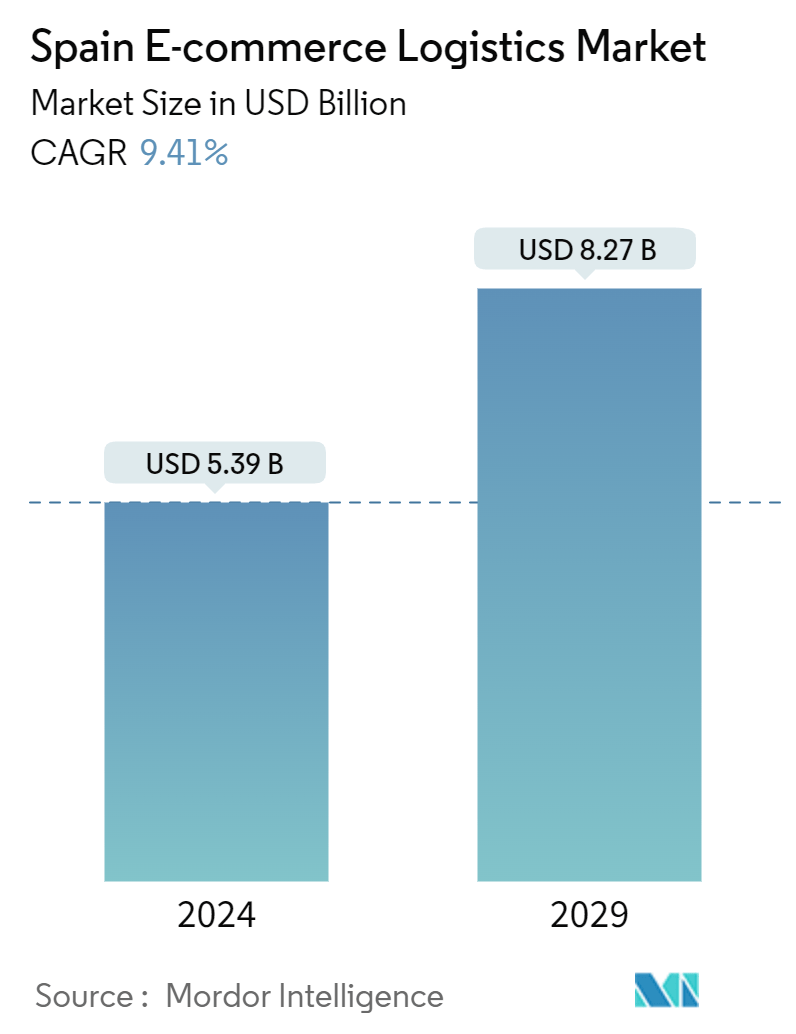
| Study Period | 2020 - 2029 |
| Base Year For Estimation | 2023 |
| Market Size (2024) | USD 5.39 Billion |
| Market Size (2029) | USD 8.27 Billion |
| CAGR (2024 - 2029) | 9.41 % |
| Market Concentration | Low |
Major Players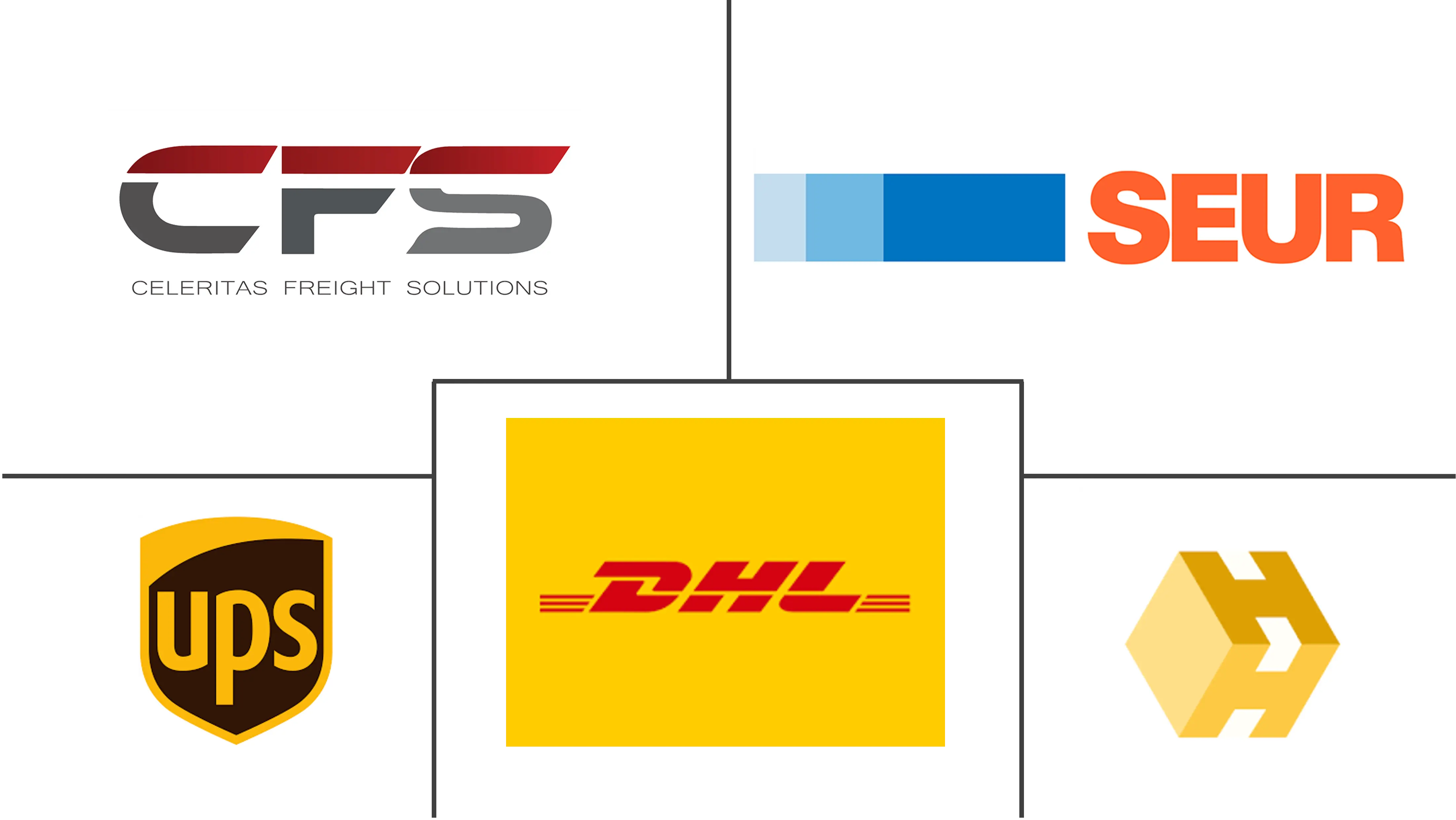
*Disclaimer: Major Players sorted in no particular order |
Spain E-commerce Logistics Market Analysis
The Spain E-commerce Logistics Market size is estimated at USD 5.39 billion in 2024, and is expected to reach USD 8.27 billion by 2029, growing at a CAGR of 9.41% during the forecast period (2024-2029).
As indicated by industry experts, in 2022, about 5.50 million people between 35 and 44 years of age bought products or services online in the Spanish e-commerce market, followed by 5.45 million users aged between 45 and 54 years.
According to 25% of Statista survey respondents, comfort was among the main reasons Spanish consumers bought certain products online rather than from bricks and mortar shops in 2022. In addition, 14% of respondents said that they had purchased online due to better prices, discounts, or offers. However, only 5% of the sample mentioned the easy process as the driving factor for online shopping.
As per a study conducted in July 2023 by industry experts, Spain ranked fifth in terms of e-commerce expenditure among other participating countries. E-commerce penetration surged during the pandemic, though moderated shortly after the ending of lockdown restrictions and the re-opening of physical retail stores.
Spain E-commerce Logistics Market Trends
The Rise in the Number of Online Shoppers
According to the National Statistics Institute of Spain, in 2022, 31.7% of businesses were involved in e-commerce, increasing the volume of business by 20.3% compared to 2021. In order to cope with changing consumer preferences and market dynamics, a number of businesses have undertaken digital transformation initiatives.
A Eurostat report published in 2023 stated that the percentage of internet users who bought e-commerce goods and services leaped from 67% in 2020 to 76% in 2023. More people will be able to access online shopping platforms due to an increase in the overall internet penetration rate in Spain.
The Spanish population's access to the Internet increased from 87% in 2018 to 95% by 2023, according to a report compiled by industry experts for that year. Spain has been a driving force for 5G and its development and continues to support the Union, as outlined in the Communication Secure 5G Deployment in the European Union, published in January 2020.
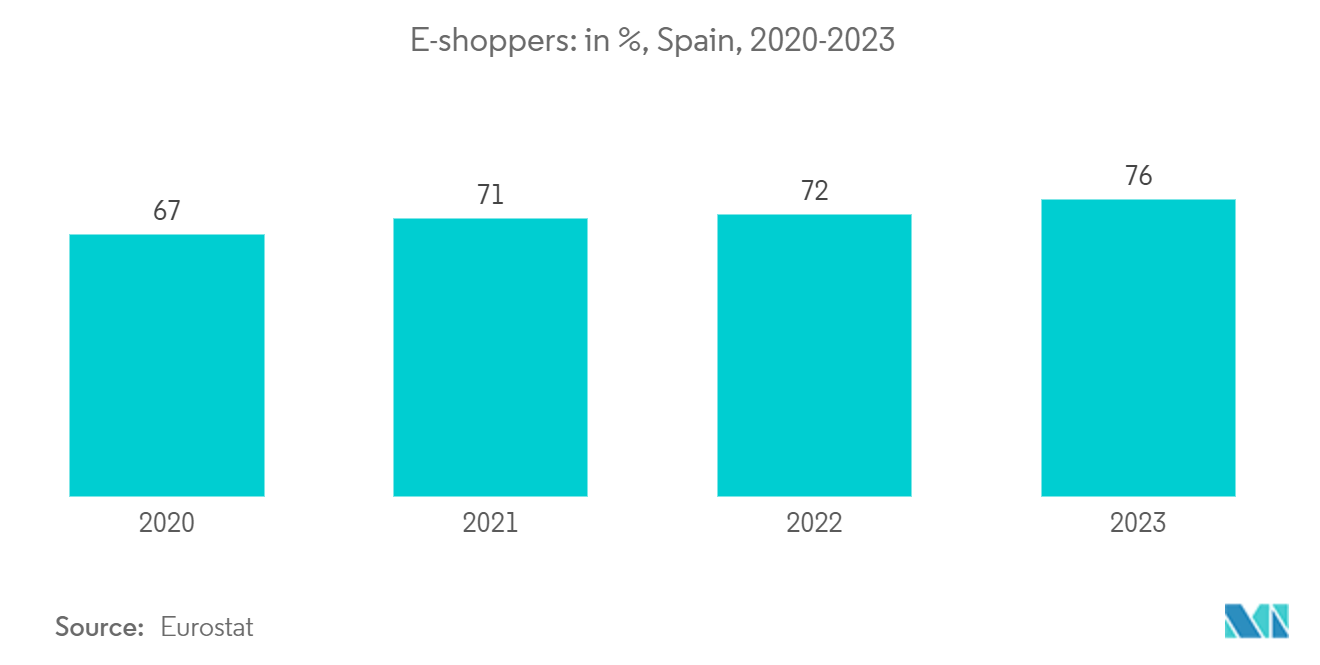
Warehouse Rent on the Rise
In 2022, Madrid’s logistics market reached a take-up volume of 1.26 million sq. m, a 5% increase from 2012. There was a strong demand for logistics space, with 92 transactions recorded compared to 86 in 2021.
By the end of 2022, the Valencia logistics market had almost 390,000 sq. m of take-up, exceeding the previous year’s record by 3% (377,000 sq. m).
In 2022, Madrid's rent for warehouses sized over 5,000 sq. m remained steady at EUR 75 (USD 80.48) per square meter since 2020, according to industry reports. Meanwhile, rent for warehouses in Valencia shot from EUR 54 (USD 57.95) in 2021 to EUR 66 in 2022. Barcelona also recorded an increase in rent from EUR 87 (USD 93.36) in 2021 to EUR 90 (USD 96.58) in 2022 per sq. m.
The Catalan logistics market in Barcelona continued its positive trend in 2022. As per sources, warehouse take-up exceeded 821,000 sq. m, distributed across 60 transactions in Barcelona.
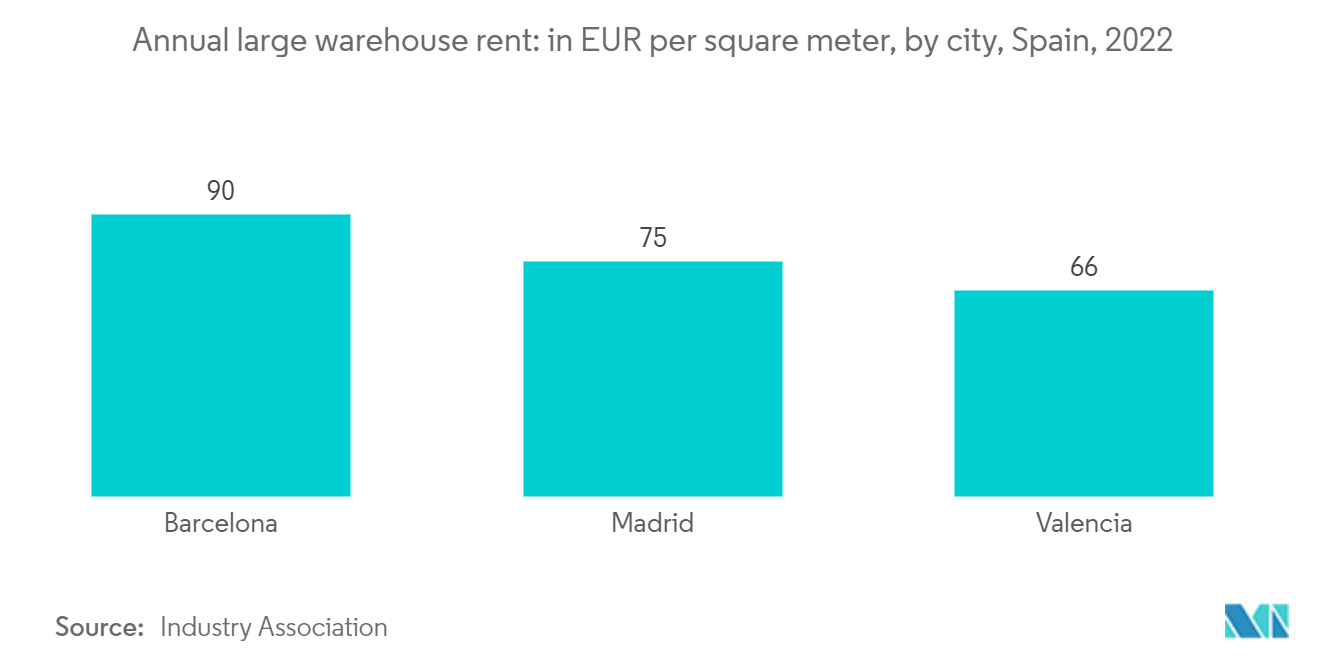
Spain E-commerce Logistics Industry Overview
The market for e-commerce logistics in Spain is competitive, owing to the presence of various companies. The e-commerce logistics market in Spain is fragmented and depicts intense competition among the market players. The competitive landscape is dynamic, with ongoing developments and competition driving companies to adapt to emerging trends, technological progress, and changing consumer preferences. Global logistics giants such as UPS have a strong presence, providing a range of services from express delivery to supply chain management. However, the e-commerce logistics industry in Spain has low to moderate barriers to entry, allowing new companies to enter the market. DHL International Gmbh, Celeritas, and Seur are among the most important players in this market.
Spain E-commerce Logistics Market Leaders
-
UPS
-
DHL
-
Celeritas
-
SEUR
-
Amphora Logistics
*Disclaimer: Major Players sorted in no particular order
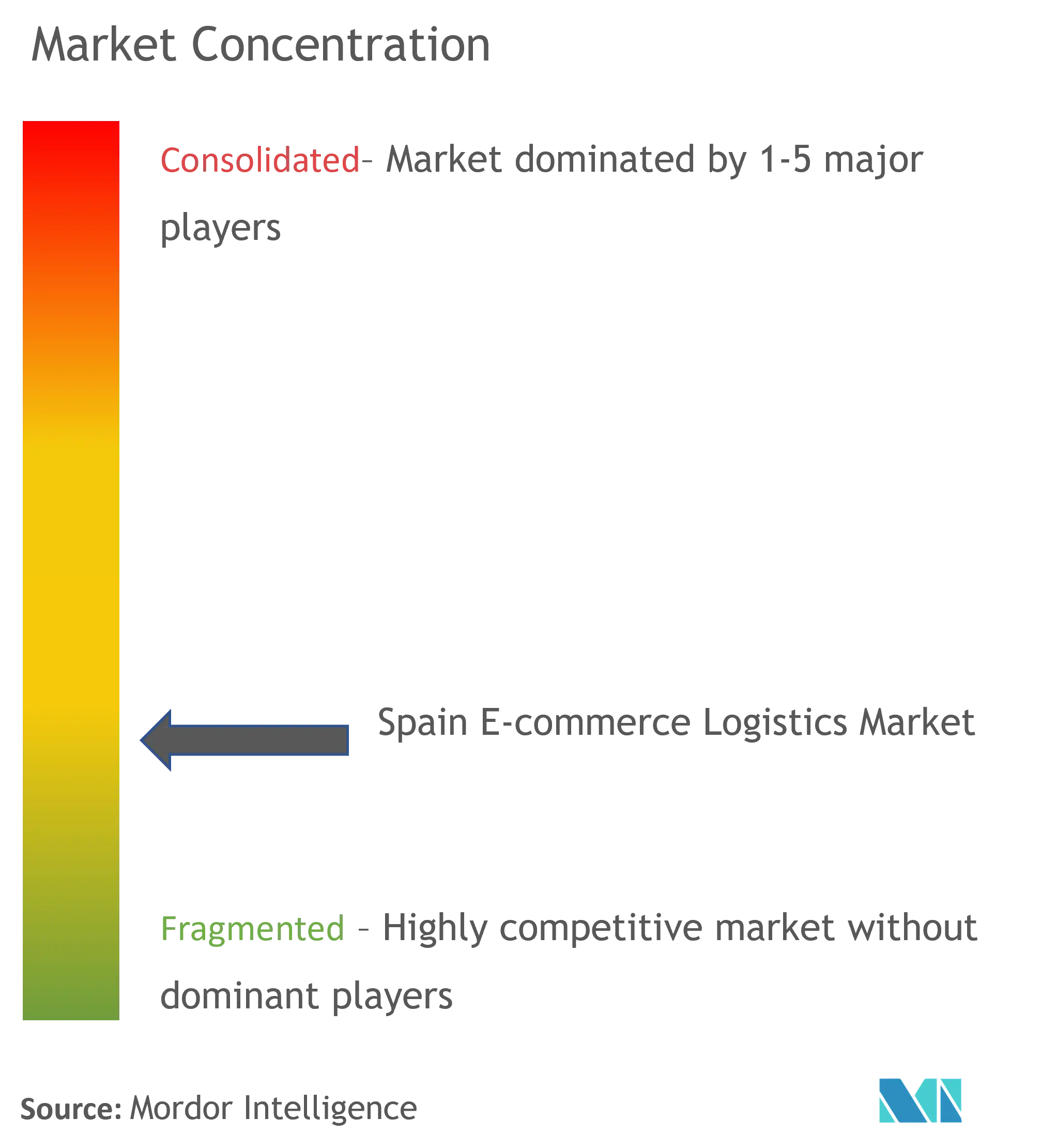
Spain E-commerce Logistics Market News
November 2023: DB Schenker opened operations at one of the largest automated e-commerce facilities in Spain, servicing retail customers in Spain. The 50,000 sq. m state-of-the-art warehouse in the city of Guadalajara started operations with 150 employees in the newly created jobs, over 200 robots, and an optimized packaging system. The site has a goods-to-person picking system capable of handling approximately 120,000 units daily, based on autonomous mobile robots (AMR) delivered by Geek+, the world’s leading provider of AMR technology.
October 2023: Alibaba Group Holding Ltd’s logistics arm, Cainiao Network, was striding its efforts to develop logistics networks and expand its services in Europe. Cainiao’s last-mile delivery service in Spain is available in nine major cities, including Madrid and Barcelona. It also offers two-day delivery in more than 20 Spanish cities. The delivery network is supported by smart logistics infrastructure investments, such as automated sorting centers (ATS) and parcel lockers.
Spain E-commerce Logistics Market Report - Table of Contents
1. INTRODUCTION
- 1.1 Study Deliverables
- 1.2 Study Assumptions
- 1.3 Scope of the Study
2. RESEARCH METHODOLOGY
3. EXECUTIVE SUMMARY
4. MARKET INSIGHTS
- 4.1 Current Market Scenario
- 4.2 Technological Trends
- 4.3 Industry Value Chain Analysis
- 4.4 Government Regulations and Initiatives
- 4.5 Insights into the E-commerce
- 4.6 Value Chain / Supply Chain Analysis
- 4.7 Demand and Supply Analysis
5. MARKET DYNAMICS
-
5.1 Drivers
- 5.1.1 Growth of B2C E-commerce
- 5.1.2 Urbanization and Population Density
-
5.2 Restraints
- 5.2.1 Infrastructure Challenges
- 5.2.2 Last-mile Delivery Complexities
-
5.3 Opportunities
- 5.3.1 Cross-border E-commerce Expansion
-
5.4 Industry Attractiveness - Porter's Five Forces Analysis
- 5.4.1 Bargaining Power of Suppliers
- 5.4.2 Bargaining Power of Consumers / Buyers
- 5.4.3 Threat of New Entrants
- 5.4.4 Threat of Substitute Products
- 5.4.5 Intensity of Competitive Rivalry
6. MARKET SEGMENTATION
-
6.1 By Service
- 6.1.1 Transportation
- 6.1.2 Warehousing and Inventory Management
- 6.1.3 Value-added Services (Labeling and Packaging )
-
6.2 By Business
- 6.2.1 B2B
- 6.2.2 B2C
-
6.3 By Destination
- 6.3.1 Domestic
- 6.3.2 International/Cross-border
-
6.4 By Product
- 6.4.1 Fashion and Apparel
- 6.4.2 Consumer Electronics and Home Appliances
- 6.4.3 Furniture
- 6.4.4 Beauty and Personal Care Products
- 6.4.5 Other Products (Toys, Food Products, etc.)
7. COMPETITIVE LANDSCAPE
- 7.1 Overview (Market Concentration and Major Players)
-
7.2 Company Profiles
- 7.2.1 FedEx Corporation
- 7.2.2 UPS
- 7.2.3 DHL
- 7.2.4 Amphora Logistics
- 7.2.5 CTT Express
- 7.2.6 Celeritas
- 7.2.7 Correos Express
- 7.2.8 Citibox
- 7.2.9 SEUR
- 7.2.10 Nacex*
- *List Not Exhaustive
- 7.3 Other Companies
8. MARKET OPPORTUNITIES AND FUTURE TRENDS
9. APPENDIX
** Subject To AvailablitySpain E-commerce Logistics Industry Segmentation
E-commerce logistics include a wide range of activities and solutions facilitating the efficient and smooth management of supply chains for online retailing businesses. The services include order fulfillment, warehousing and storage, transportation, reverse logistics, and technology integration. In order to guarantee the seamless movement of goods from origin to the final consumer, logistics providers need to be flexible, incorporating new technologies and addressing changes in consumer preferences if they are to maintain their competitiveness in the market as e-commerce evolves.
The report includes a comprehensive background analysis of the Spanish e-commerce logistics market, covering the current market trends, restraints, technological updates, and detailed information on various segments and the competitive landscape of the industry. The impact of COVID-19 has also been incorporated and considered during the study.
The Spanish e-commerce logistics market is segmented by service (transportation, warehousing, and inventory management, and value-added services (labeling and packaging), by business (B2B and B2C), by destination (domestic and international/cross border) and by-product (fashion and apparel and consumer electronics, home appliances, furniture, beauty and personal care products, and other products (toys, food products, etc.)).
The report offers market size and forecasts for the Spanish e-commerce logistics market in value (USD) for all the above segments.
| By Service | Transportation |
| Warehousing and Inventory Management | |
| Value-added Services (Labeling and Packaging ) | |
| By Business | B2B |
| B2C | |
| By Destination | Domestic |
| International/Cross-border | |
| By Product | Fashion and Apparel |
| Consumer Electronics and Home Appliances | |
| Furniture | |
| Beauty and Personal Care Products | |
| Other Products (Toys, Food Products, etc.) |
Spain E-commerce Logistics Market Research FAQs
How big is the Spain E-commerce Logistics Market?
The Spain E-commerce Logistics Market size is expected to reach USD 5.39 billion in 2024 and grow at a CAGR of 9.41% to reach USD 8.27 billion by 2029.
What is the current Spain E-commerce Logistics Market size?
In 2024, the Spain E-commerce Logistics Market size is expected to reach USD 5.39 billion.
Who are the key players in Spain E-commerce Logistics Market?
UPS, DHL, Celeritas, SEUR and Amphora Logistics are the major companies operating in the Spain E-commerce Logistics Market.
What years does this Spain E-commerce Logistics Market cover, and what was the market size in 2023?
In 2023, the Spain E-commerce Logistics Market size was estimated at USD 4.88 billion. The report covers the Spain E-commerce Logistics Market historical market size for years: 2020, 2021, 2022 and 2023. The report also forecasts the Spain E-commerce Logistics Market size for years: 2024, 2025, 2026, 2027, 2028 and 2029.
Spain E-commerce Logistics Industry Report
Statistics for the 2024 Spain E-commerce Logistics market share, size and revenue growth rate, created by Mordor Intelligence™ Industry Reports. Spain E-commerce Logistics analysis includes a market forecast outlook for 2024 to 2029 and historical overview. Get a sample of this industry analysis as a free report PDF download.



